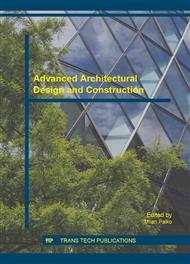[1]
L. ŠÍP, Udržateľná architektúra. in: R. Špaček a H. Pifko (Eds. ), Rukoväť udržateľnej architektúry, Vydavateľstvo tlačovín Slovenskej komory architektúry, Bratislava, 2013, pp.18-21.
Google Scholar
[2]
Ľ. VÍTKOVÁ, O. Melcarová, Ukazovatele intenzity využitia územia funkčne zmiešaného územia, in: Ľ. VÍTKOVÁ (Ed. ), Kvantitatívne parametre urbanistických štruktúr, Road, Bratislava, 2008, pp.8-16.
Google Scholar
[3]
Ľ. VÍTKOVÁ, Porovnanie ukazovateľov intenzity využitia územia pre rôzne funkčné využitia, in: Ľ. VÍTKOVÁ (Ed. ), Kvantitatívne parametre urbanistických štruktúr, Road, Bratislava, 2008, pp.27-36.
Google Scholar
[4]
E. BURTON, L. MITCHELL, Inclusive urban design: streets for life, Elsevier, Amsterdam, (2006).
Google Scholar
[5]
H. PIFKO, Základné obrysy udržateľného mesta, in: R. Špaček a H. Pifko (Eds. ), Rukoväť udržateľnej architektúry, Vydavateľstvo tlačovín Slovenskej komory architektúry, Bratislava, 2013, pp.138-143.
Google Scholar
[6]
L. LEDO, P. B. KOSASIH, P. COOPER, Roof mounting site analysis for micro-wind turbines, in: Renewable Energy, Vol. 36, Issue 5, 2011, pp.1379-1391.
DOI: 10.1016/j.renene.2010.10.030
Google Scholar
[7]
I. ABOHELA, N. HAMZA, S. DUDEK, Effect of roof shape, wind direction, building height and urban configuration on the energy yield and positioning of roof mounted wind turbines, in: Renewable Energy, Vol. 50, 2013, pp.1106-1118.
DOI: 10.1016/j.renene.2012.08.068
Google Scholar
[8]
F. TOJA-SILVA, A. COLMENAR-SANTOS, M. CASTRO-GIL, Urban Wind Energy Exploitation Systems: Behaviour Under Multidirectional flow conditions: Opportunities and challenges, in: Renewable and Sustainable Energy Reviews, Vol. 25, 2013, pp.264-378.
DOI: 10.1016/j.rser.2013.03.052
Google Scholar
[9]
A. D. PEACOCK, D. JENKINS, M. AHADZI, A. BERRY, S. TURAN, Micro wind turbines in the UK domestic sector, in: Energy and Buildings, Vol. 40, Issue 7, 2008, p.1324–1333.
DOI: 10.1016/j.enbuild.2007.12.004
Google Scholar
[10]
A.S. BAHAJ, L. MYERS, P. A. B. JAMES, Urban energy generation: Influence of micro-wind turbine output on electricity consumption in buildings, in: Energy and Buildings, Vol. 39, Issue 2, 2008, pp.154-165.
DOI: 10.1016/j.enbuild.2006.06.001
Google Scholar
[11]
M. BIELEK, P. ČERNÍK, M. TAJMÍR, Aerodynamika budov: Fyzikálne problémy účinkov vetra na budovy a ich okolie, Alfa, Bratislava, (1990).
Google Scholar
[12]
M. PIRNER, O. FISCHER, Zatížení staveb větrem, Informační centrum České komory autorizovaných inženýrů a techniků činných ve výstavbě, Praha, (2003).
Google Scholar
[13]
B. BLOCKEN, J. CARMELIET, Pedestrian Wind Environment around Buildings: Literature Review and Practical Examples, in: Journal of Thermal Envelope and Building Science, Vol. 28, Issue 2, 2004, pp.107-159.
DOI: 10.1177/1097196304044396
Google Scholar
[14]
B. KOČ, Šance pro vítr, EkoCentrum, Brno, (1996).
Google Scholar
[15]
R. AYNSLEY, Wind Engineering in Large Scale Urban Design, in: R. B. Malla, W. K. Binienda, and A. K. Maji (Eds. ), Earth & Space, American Society of Civil Engineers, 2006, pp.1-7.
Google Scholar
[16]
R. AYNSLEY, Work of the ASCE Task Committee on Urban Aerodynamics, in: R. B. Malla, W. K. Binienda, and A. K. Maji (Eds. ), Earth & Space, American Society of Civil Engineers, 2006, pp.1-6.
DOI: 10.1061/40830(188)107
Google Scholar


